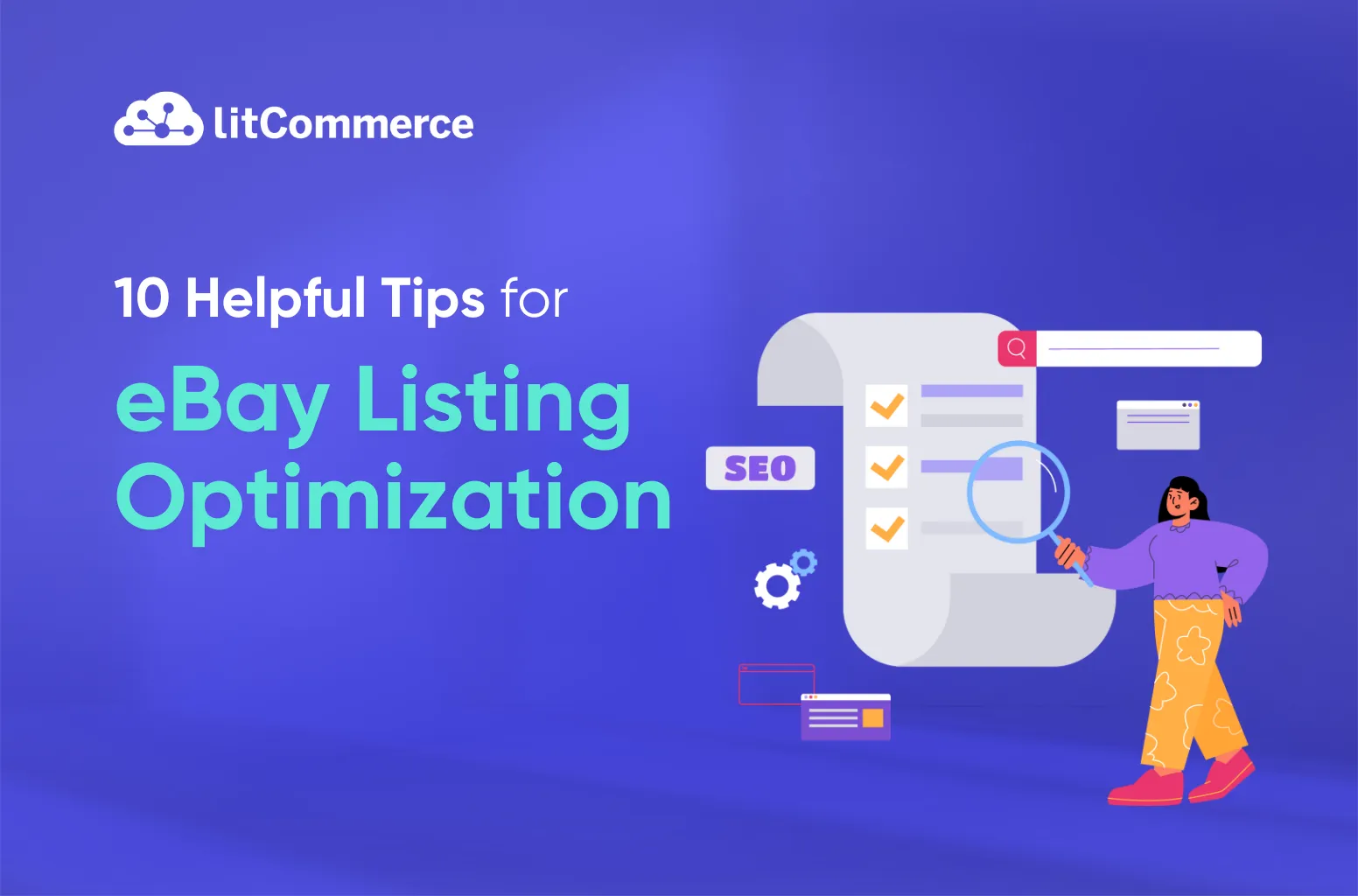Are you finding it tough to sell on eBay? With countless sellers on the platform, ranking on top pages can be a real challenge. eBay listing optimization is all about making it easier for your target audience to find your products among the 1.3 billion listings on the site. Every detail you include in your listing should be focused on providing a smooth and satisfying shopping experience for buyers.
By optimizing your eBay listing to meet the needs and desires of your customers, you’re also optimizing it for eBay’s search engine. For the best tips on optimizing your eBay listing, check out this guide to learn:
- What is an effective listing on eBay?
- How to optimize eBay listings?
10 Dos of eBay Listing Optimization
Basically, a good eBay listing can help you find buyers faster! The better your listing ranks in search results, the more likely buyers will see your products. That is why every seller needs eBay listing optimization.
But how do you know your eBay listing works? There are ways to check effectiveness. Here are some methods:
Use seller tools:
- Listing quality report: eBay offers a tool to analyze your listings and provide recommendations for improving factors like search visibility and conversion rates.
- Performance metrics: Track your listing’s performance through views, clicks, and sales. Listings with high impressions but low sales might need adjustments to descriptions or titles.
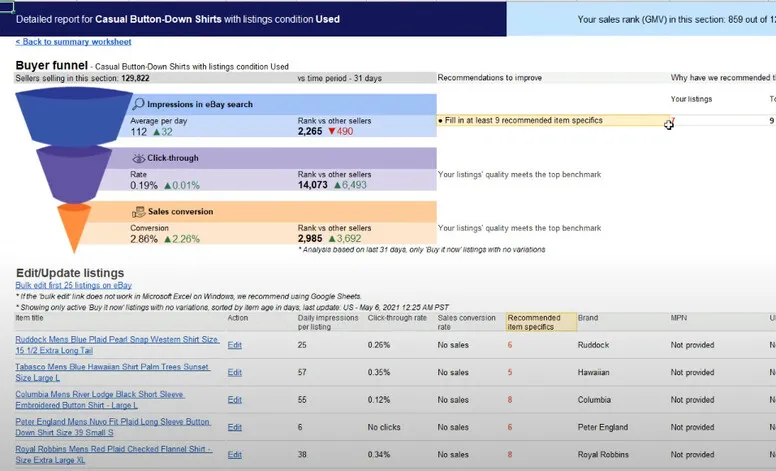
Similar to eBay SEO strategies, eBay listing optimization includes several steps regarding what you should and should not do. Below is a breakdown of these steps.
If you are interested in SEO, check our eBay SEO Guide for more helpful details.
1. Choose the right listing format
When you make a listing, you can choose the format that suits you: Auction-style or Fixed-Price format listings. Picking the right one will help you optimize eBay listings and sell your item for the best price.
Auction-style
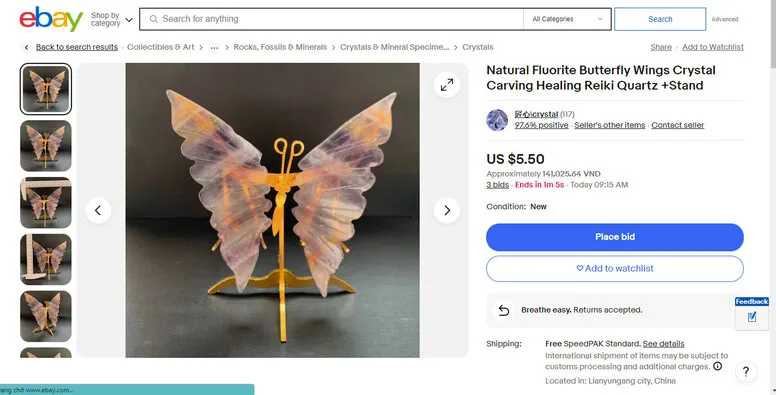
When you put up an item for sale via an eBay auction, interested buyers place bids, and the item is eventually sold to the bidder with the highest offer when the auction concludes.
You should opt for auction listings if:
- You’re uncertain about your item’s value and want eBay users to determine it.
- Your item is rare or difficult to find, which could spark high demand and bidding wars.
- Your item’s market worth might change because of seasonal trends or popularity shifts.
Fixed Price
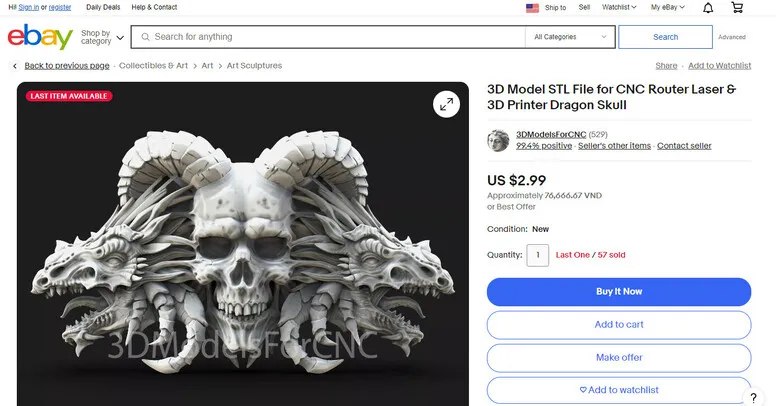
In fixed-price listings, you set a price for your item so buyers can purchase it immediately.
You should opt for auction listings fixed price format if:
- You know your item’s value or have a specific price in mind.
- You aim to display your items to potential buyers for over 10 days.
- You possess a substantial inventory.
- You have various items that can be combined into a multi-quantity or multi-variation listing.
2. Write informative titles for products
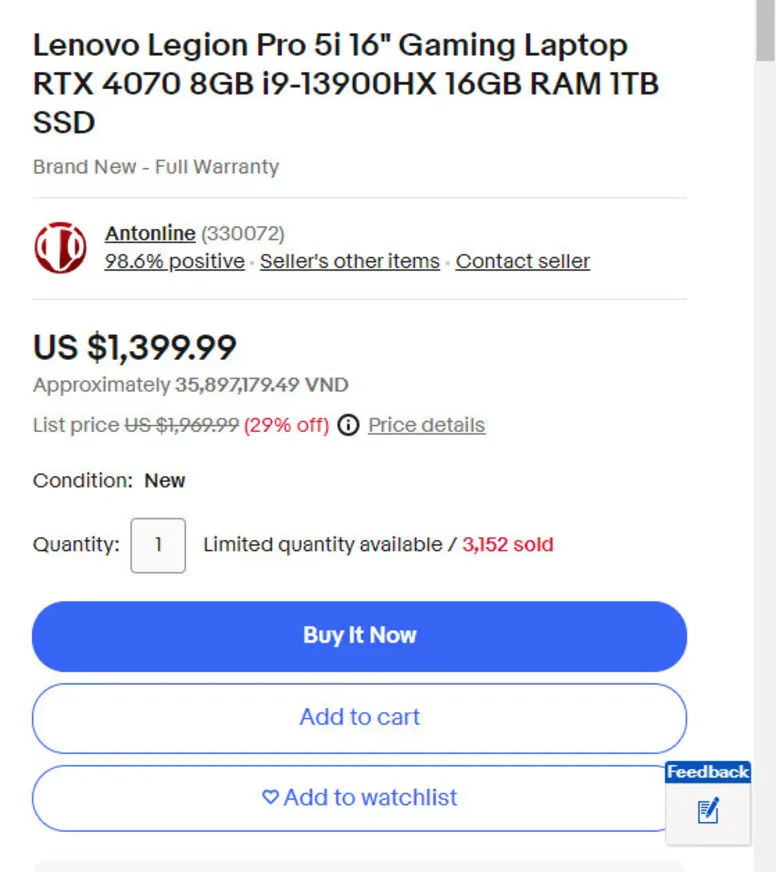
Did you know? Listings with titles over 60 characters are 1.5 times more likely to sell.
Hence, when you optimize your eBay listing, be sure to enhance your product title. An effective item title should be clear, concise, and informative. eBay’s guidelines limit titles to 80 characters, so wisely choosing your words is essential.
We suggest you check similar items to understand the titles your competitors use.
Moreover, don’t forget to include keywords in your title that potential buyers are likely to search for. If your item has variations (such as different colors), there’s no need to list them all in the title, as they’ll be indexed automatically based on the buyer’s search terms.
You can consider using the following title format suggested by eBay to optimize eBay listings:
[brand] [product name] [model number] [variants — size, color] [additional keyword].
3. Create an accurate description
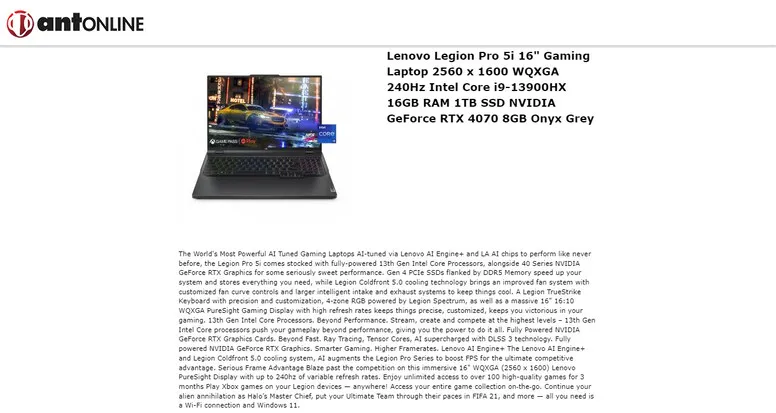
The item description helps buyers make purchasing decisions. Therefore, it must be filled out accurately for ultimate eBay listing optimization. Here are some things to avoid including in the item description:
- Conflicting product information, such as stating one capacity in the title and a different one in the description;
- Content unrelated to the item’s sale, such as political views or public service announcements;
- Personal information about yourself, your hobbies, or your products;
- Icons or logos indicate your seller status or ratings;
- Requests for buyers to give you a score to improve your rating or performance;
- Any form of active content, such as videos, animations, or widgets.
We recommend providing a detailed and precise item description, including its condition, and specifying any defects or damages.
4. Optimize your keywords for eBay SEO
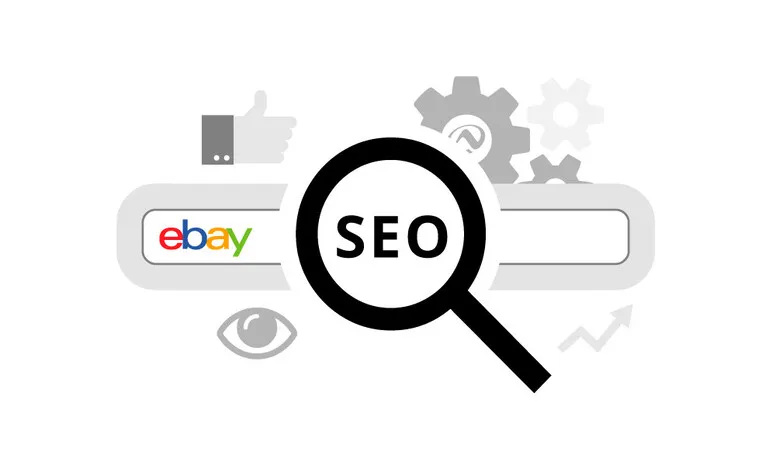
One key factor in eBay listing optimization for better visibility is SEO or Search Engine Optimization. In other words, you should research and add the right keywords to your listing to improve the chances of potential buyers finding your items.
Several helpful SEO tools are available to assist you in selecting the right keywords to optimize eBay listings. By conducting keyword research and using these tools effectively, you can significantly boost your listing’s visibility and reach more customers.
As a general rule, focus on selecting three to five keywords to target. You can incorporate these relevant keywords in different parts of your listing:
- Title: Include the most relevant and high-volume keywords in your title.
- Subtitle: Use additional keywords in the subtitle, which may include details like color, size, or product category.
- Description: Integrate related keywords throughout your description as you provide details about the item’s features, appearance, and overall quality.
5. Optimize product pricing
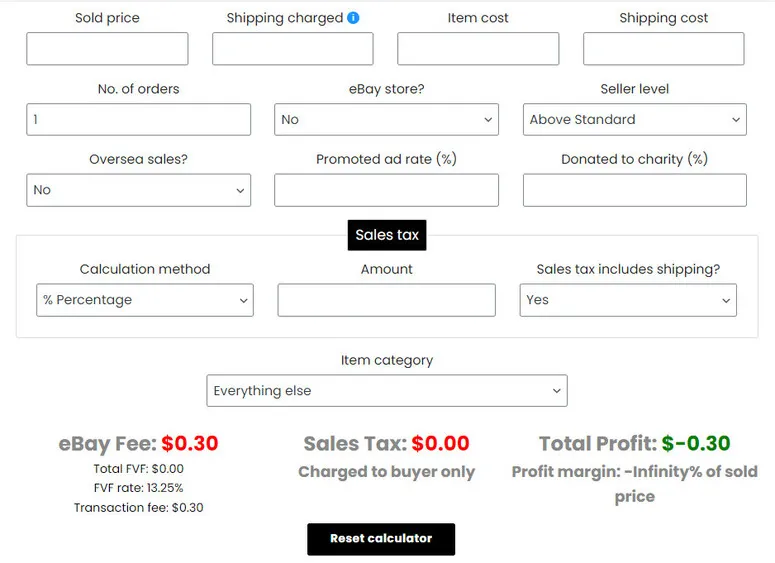
Pricing isn’t part of eBay SEO, but it’s a crucial part of eBay listing optimization for boosting sales. You need to balance competitiveness with profitability when setting prices for your listing. You can follow these tips to price your items strategically to optimize eBay listings:
- Research similar products to adjust pricing, consider costs like production and shipping, and factor in any fees.
- Offer volume discounts can attract more sales;
- Ensure your prices are competitive, but don’t undervalue your products;
- Use eBay’s tools to calculate profits from discounts;
- Review and adjust prices periodically to stay competitive.
Learn more about starting to list an item on eBay with the LitCommerce guide here.
6. Include unique identifiers

Product Identifiers are codes found on every product, making it easier for shoppers to find and buy items. So, if you want to optimize eBay listings, don’t forget to add identifiers such as UPCs and ISBNs to your listing. These special numbers help search engines find products for shoppers ready to buy.
Luckily, eBay does allow you to easily add these codes to your listing. Just remember to include identifiers along with a detailed description, not instead of it.
7. Add multiple images
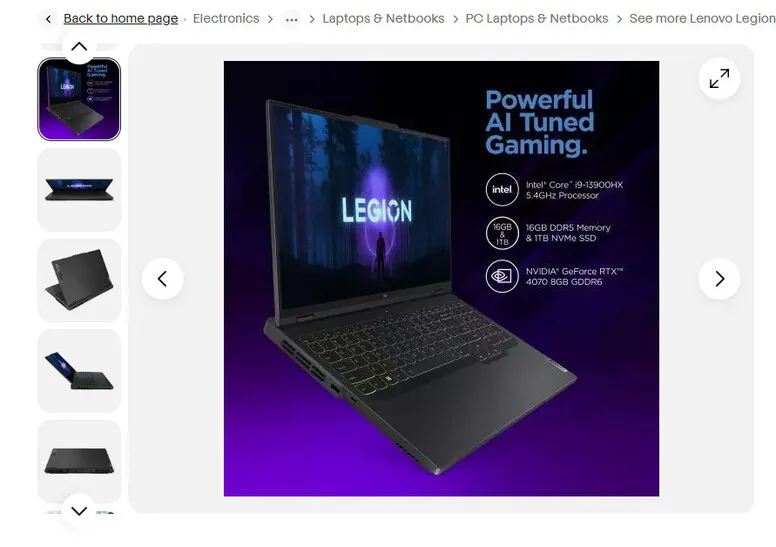
Based on research conducted by eBay, listings with higher-quality photos are more likely to sell, with up to a 5% increase in sales probability. Good photo quality refers to images that are at least 500 pixels on the longest side, free from added text or graphics, and uploaded using eBay’s picture service.
Here are some more guidelines to follow for eBay listing optimization with product photos:
- Take advantage of the option to upload 12 product photos of your item for free;
- Capture your item from various angles and take close-up shots to highlight details;
- Avoid adding borders or text to your photos;
- Strictly follow copyright laws and be cautious when using images that you do not have the right to.
Not only you can list multiple product images on eBay to boost sales, you can also learn how to list multiple items on eBay with LitCommerce.
8. Include product videos
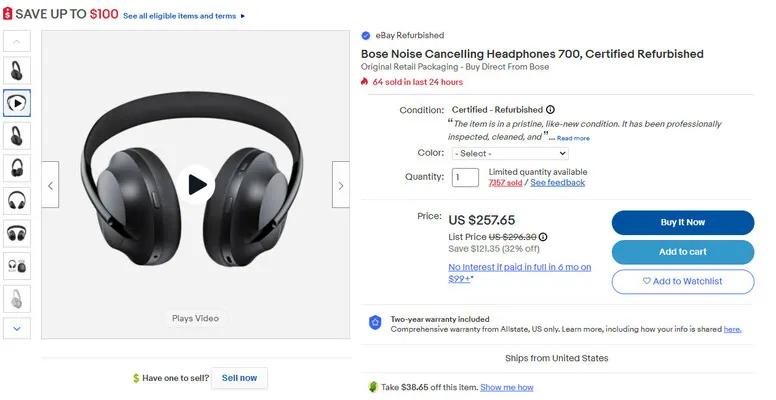
In some cases, photos may not fully capture your item’s features or functionality. However, you can enhance your listing by uploading a video to showcase your product or demonstrate it in action. The video will appear in the second position within the photo gallery.
The most effective types of videos include:
- Product instructions and how-to guides;
- Installation guides, especially for Parts & Accessories;
- Do-it-yourself (DIY) tutorials, such as a recipe using a kitchen appliance;
- Unboxing videos to show the item’s packaging and contents;
- Videos that provide clarity on the item’s condition;
9. Offer free and reliable shipping
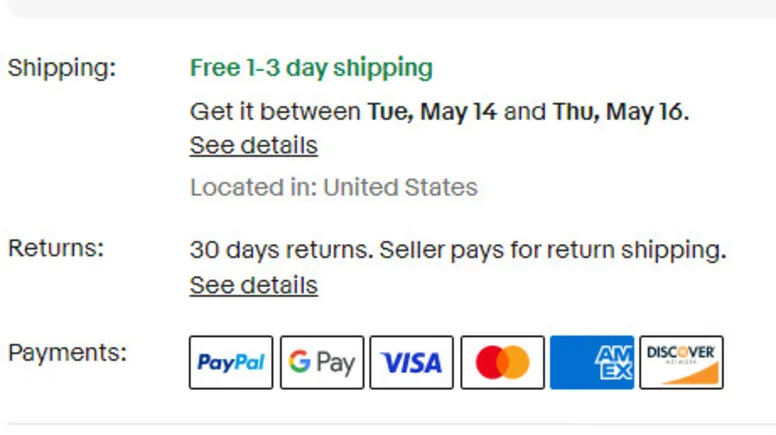
If you provide free shipping to customers, you increase your visibility in “free shipping” searches, attracting more buyers who prefer this option. This eBay listing optimization helps you stay competitive with other sellers.
Additionally, maintaining reliability in your shipping practices builds a positive rapport with customers. By setting clear expectations and consistently meeting shipping deadlines, you enhance your visibility to eBay shoppers.
10. Have buyer-friendly policies

It’s important to ensure that your buyers understand your Return Policy, including specifying a Handling Time.
eBay suggests offering a generous returns policy, setting a return window of at least 4 weeks to enhance visibility among potential customers. When creating your listing, include detailed guidelines outlining the return window, exceptions, and other expectations.
6 Don’ts of eBay Listing Optimization
1. Don’t stuff with keyword

While using appropriate keywords can improve your eBay SEO, overloading your listing with too many keywords can actually harm your visibility. This practice, known as keyword stuffing, is viewed as an attempt to manipulate search engines in a negative way.
As you integrate keywords into your description, it’s important to limit the number of keywords to less than five. And, you should not repeat keywords or any word in a keyword or title.
2. Don’t include identifiers without a product description
Using ISBNs and UPCs correctly can help with eBay listing optimization. However, if you simply include a product number without providing a comprehensive description, eBay might remove the listing. To prevent this and maintain your visibility, ensure that you include a description of 200 to 300 words that cover the brand, category, and function of your product.
3. Don’t use low-quality photos
Using blurry photos can attract negative attention from both eBay and customers. This is understandable because customers want to see accurate images of the product they’re considering buying. To avoid this, take the time to upload professionally staged photos taken with a high-quality camera.
4. Don’t duplicate your listings

Some sellers try to gain an advantage by creating multiple listings for the same products or using multiple accounts. Though you have done some eBay listing optimization to a listing in one account, stop copying it to the others. eBay is actively working to remove these duplicates. Plus, duplicate listings can confuse eBay’s search algorithms, causing your listings to appear lower in search results. Duplicate listings also confuse buyers, leading to lower trust in your brand and potentially lost sales.
To avoid this problem, it’s best to:
- Create one unique listing for each product
- Avoid copying other listings totally if you offer similar products
- Report others whose listings look like yours.
5. Don’t redirect buyers to other sites
eBay allows all users to make creative descriptions to showcase their products. However, some new sellers mistakenly try to divert eBay shoppers to their external online stores. That goes against the platform’s listing rules and can harm their visibility. When creating your listing, avoid the following actions:
- Directing potential customers to your external online store;
- Providing links to the same product on a different online marketplace at a lower price;
- Adding links to sign up for email campaigns;
- Including links to your other products;
6. Don’t give up
It’s common for sellers to feel discouraged and consider deleting their eBay accounts when they don’t see immediate results. However, a better approach is to persist with your new eBay account. Optimizing your listings and improving your visibility takes time. Even with enhancements to your item listings, seeing your products rise in eBay’s search results may take weeks or months.
The longer you stay active on the platform, the more opportunities you have to develop positive SEO attributes. With time, both eBay and your customers will come to view you as a trustworthy seller, leading to increased visibility and success.
eBay Listing Optimization: FAQs
Creating a successful eBay listing hinges on capturing attention and instilling confidence in potential buyers. Here are some essential components: To optimize eBay listings, you can enhance these aspects: Although ChatGPT can be helpful for certain aspects of eBay listing optimization, you should employ it wisely and understand its constraints. Sellers can leverage ChatGPT for: However, it’s essential to be mindful of its accuracy and originality. When using this AI tool, always provide context, verify the content promptly, and be prepared to edit the generated text accordingly. There is no direct way to pay for a guaranteed higher ranking in eBay search results. However, eBay does offer an advertising option called Promoted Listings that can increase your listing’s visibility. Promoted Listings can be an excellent way to get more exposure for your items, but it’s essential to use them strategically. Consider your budget, profit margins, and competition before using Promoted Listings.
Time to Start Optimizing Your eBay Listings
eBay listing optimization is essential for success in this marketplace. By following the mentioned tips effectively, you can significantly enhance your chances of getting your listings featured in eBay’s search engine results. Plus, keeping yourself informed about eBay’s policies and tools is important as the platform regularly updates them to help sellers maximize their profits.
If you need more tips on selling on eBay or other marketplaces, check out our eCommerce blog. Otherwise, contact us now for direct support. LitCommerce is available 24/7 to assist you.

